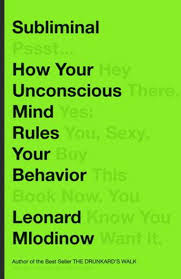Author(s): Leonard Mlodinow
ISBN: 978-0-307-47225-0
APA Style =Citation:
Mlodinow, Leonard (2012). Subliminal: How Your Unconscious Mind Rules Your Behavior. New York: Vintage Books.
| open_your_class_with_this_tomorrow_subliminal_3-1.pdf |
Subliminal provides insight into how modern neuroscience is revealing the ways in which our unconscious minds influence a wide range of our behaviors. The author Leonard Mlodinow is a physicist who has had a very diverse career including working as a Hollywood screen writer and an award winning video game designer has the ability to make complex scientific research accessible, engaging, and entertaining making this a book suitable for both instructors and students. Early psychologists were limited to methods such as introspection, free association, observation, implanting electrodes, and studying behavior of animals after damage to examine the unconscious. Modern methods now include advanced scanning equipment which allows specific and scientific examination of how the unconscious mind operates. This book chronicles numerous interesting and enlightening studies which highlight the ways our unconscious minds influence our behavior. Unlike the unconscious dominated by sexual and aggressive urges and unresolved childhood conflicts described by Freud, Mlodinow shows us that thoughts which are unconscious are adaptive. Unlike in the Freudian model where unconscious thoughts are blocked through defense mechanisms such as repression neuroscience reveals that these processes are inaccessible because of the design of the brain.
The book is organized into two halves each of which is packed with current, relevant research including both controlled experiments and fascinating case studies. The first half of the book is titled The Two-Tiered Brain and describes the modern understanding of the unconscious. The author separates conscious from unconscious cognition and provides evidence for how the unconscious mind influences such diverse behaviors as who we marry, who we vote for, what we order in a restaurant, how much we enjoy food, what products we buy, the prejudices we hold, the perceptions we form, and the memories we create. Research shows that not only do we make often significant decisions based on unconscious reactions, but that after the decision is made we use our conscious minds to explain that we did this in a logical and reasoned manner.
The second half of the book is titled The Social Unconscious and it examines how our unconscious minds allow us to rapidly interpret and communicate via non-verbal signals. In one interesting experiment researchers filmed a variety of subjects with about twelve small lights spread around their body in a dark room so that only the lights were visible. If the participants were stationary it gave the appearance of a meaningless collection of lights, but if they moved viewers were able to determine a large amount of information about the individual wearing the lights. Viewing the lights in motion allowed individuals to identify gender, and even the specific identity of the person if they already knew them simply by how they walked. If actors wearing the lights portrayed specific emotions, viewers were easily able to correctly identify what was being demonstrated. Subliminal makes sophisticated scientific research about the unconscious mind easily understandable to a wide range of readers by using humor and accessible language to make interesting case studies, anecdotes, and research experiments come to life. This book provides insight into the unconscious influences that impact our interactions with family, friends, bosses, coworkers, and strangers and illustrates how this knowledge can allow us to make better decisions and better predict the behavior of others.
Other Related Resources
Leonard Mlodinow giving a 50-minute presentation at Google regarding his 2008 book titled The Drunkard’s Walk: How Randomness Rules Our Lives and discusses various types of cognitive biases.
http://www.youtube.com/watch?v=F0sLuRsu1Dohttp://www.youtube.com/watch?v=F0sLuRsu1Do
Leonard Mlodinow giving a 50-minute presentation at Google about many of the concepts related to his current book, Subliminal. Mlodinow’s talk includes many demonstrations such as ones about the anchoring bias and false memories, which could be used in the classroom.
http://www.youtube.com/watch?v=NJ-IfVHJH58
In the book the author presents research about the subliminal aspects of the developmental psychology concept of theory of mind (TOM). TOM is the ability to understand the thoughts and intentions of others and predict their behavior which begins to develop around the age of four. Although some aspects of TOM are conscious, much of our ability to read the intentions of others occurs as an automatic aspect of the unconscious mind. The basics of TOM are a critical part of cognitive development in children which can be tested by a false belief test. The following video offers a short demonstration for students of how theory of mind develops in children.
http://www.youtube.com/watch?v=8hLubgpY2_w
Psychological Figures and Concept
Charles Darwin
Paul Ekman
Sigmund Freud
William James
Stanley Milgram
Muzafer Sherif
Stanley Schachter
Wilhelm Wundt
Anchoring bias
Blindsight
Change blindness
Confabulation
Duchenne Smile
Emotion
Eyewitness testimony
fMRI
False memories
Gender stereotypes
Implicit Association Test (IAT)
In-group bias
Introspection
Language
Memory
Motivation
Neuroscience
Norms
Overconfidence
Prejudice
Social neuroscience
Split-brain research
Theory of mind (TOM)

 RSS Feed
RSS Feed